Range Rover Evoque: Body Closures - Component Location, System Operation and Component Description
Component Location
Powered Tailgate - Component Location
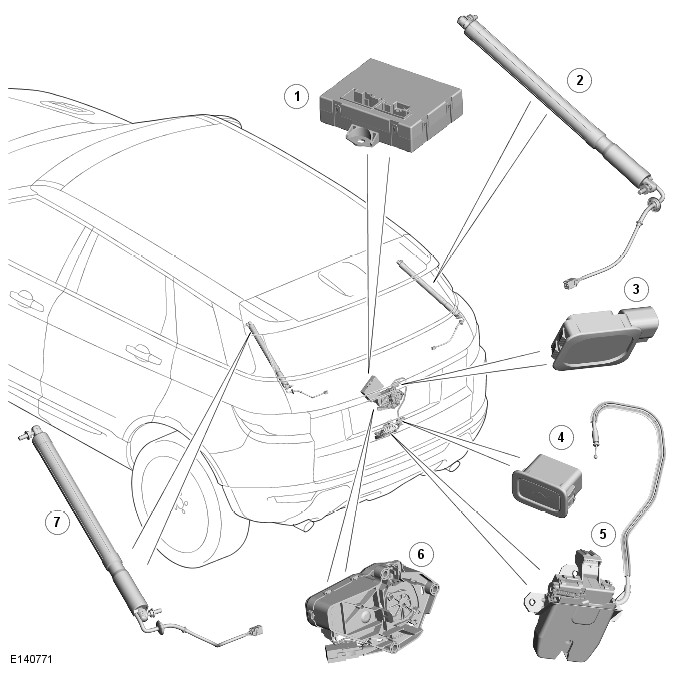
- Tailgate module
- Powered strut
- Tailgate open button
- Tailgate close button
- Latch assembly
- Powered cinch motor
- Powered strut
OVERVIEW
Tailgate
The tailgate is constructed from two lightweight plastic composite parts (inner and outer lower), which are bonded together to make the finished single piece tailgate. The outer lower is constructed from polypropylene, similar to a bumper construction to provide increased bump resistance.
Depending on vehicle specification the tailgate is offered with either:
- manual opening and closing, or with a
- powered opening and closing function.
The powered tailgate is opened and closed by two electrically driven spindles mounted in place of the gas struts as used on the manual tailgate.
The spindle assembly has ball joints at either end allowing it to articulate between the fixed mounts on the vehicle. The nominal opening and closing time of the system is 5 seconds (+/2.0 seconds).
The tailgate operates using an electronic latch with the addition of a soft-close power cinching unit to pull the latch closed for the last 6 mm of travel (soft close). The latch and power-cinch unit are both located in the tailgate.
In addition to the powered movement of the tailgate, the closing mechanism of the tailgate has a soft-close power cinching unit. The cinching unit pulls the latch closed at the end of the tailgate's travel, once the latches' secondary switch is reached. The latch and power-cinch unit are both housed within the tailgate.
System Operation and Component Description
Control Diagram
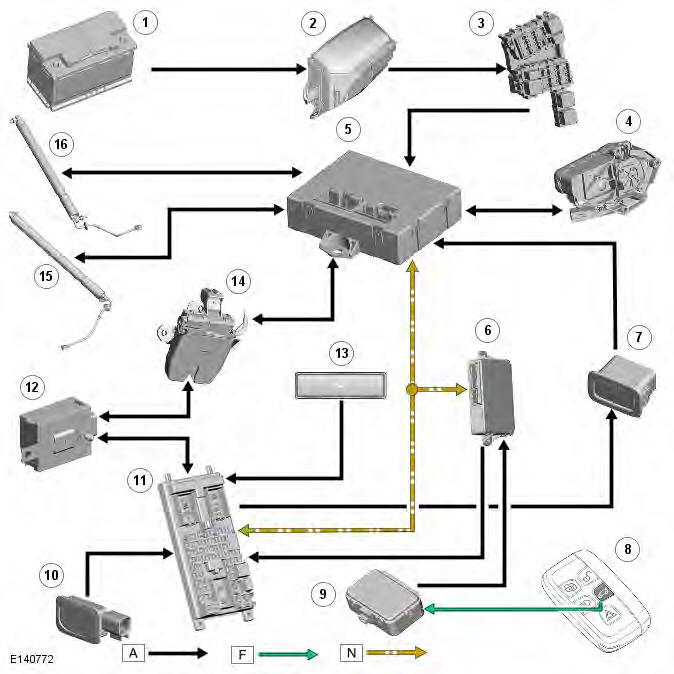
A = Hardwired; F = RF (radio frequency) Transmission; N = Medium-Speed CAN (controller area network)
- Battery
- EJB (engine junction box)
- RJB (rear junction box)
- Powered cinch motor
- Tailgate module
- KVM (keyless vehicle module)
- Close switch - tailgate close edge
- Release button - Smart Key
- Radio frequency receiver
- Release switch - number-plate plinth
- CJB (central junction box) incorporating the BCM (Body Control Module)
- RF (radio frequency) filter - rear wiper motor
- Release switch - vehicle interior
- Latch assembly
- Powered strut
- Powered strut
System Operation
Powered Tailgate
The powered opening and closing actions are controlled by the tailgate module. The module receives a permanent battery power supply from the RJB.
To initiate the tailgate opening sequence a 'tailgate release-request' is received by the CJB from one of the following:
- KVM (keyless vehicle module) - signal originates from the Smart Key tailgate release button.
- Instrument panel, interior tailgate switch.
- Rear number-plate-plinth, exterior tailgate switch.
The CJB responds with the following simultaneous actions:
- A hardwire power release to the latch actuator mechanism.
- A powered opening request-signal transmitted to the tailgate module via the medium speed CAN bus.
The processing of the opening signal by the CJB is influenced by a number of factors:
- Source of 'opening signal'.
- Vehicle status: locked or unlocked.
- Vehicle equipped with or without passive entry,
- Vehicle speed and gear position.
Once the latch is released the tailgate module actuates the motors located in each powered strut to raise the tailgate to its fully open or pre-set position. When the tailgate is in its opening cycle the automatic stop-position of the tailgate is functioned by a hall-sensor located in the motor. The hall-sensor signal transmitted to the tailgate module is synchronized with the pre-set memory indicating the stop position of the tailgate.
To close the tailgate a hardwired signal is transmitted directly to the tailgate module when the switch located on tailgate's closing edge is pressed and then released. The module operates the spindle motors in the opposite direction to close the tailgate to the latch position.
When the latch engages with the striker plate a signal transmitted from the latches' secondary switch, located in the actuator mechanism, to the tailgate module confirms the latch is engaged. The module de-activates the spindle-drive and activates the power cinch-motor to pull the latch closed through the last 6mm of travel. This is the latches primary fully-closed position. The power cinch motor then reverses to allow the latch to be opened upon the next release request. A mechanical Bowden cable connection between the motor and latch assembly is used to complete the closing process of claw contraction and then reverse.
If the battery is disconnected when the tailgate is closed, the stored and calibrated tailgate opening heights will remain stored when the battery is reconnected. However if power supply to the tailgate module is disconnected when the tailgate is open the system will not recognize the tailgate's position and subsequently will not function to any switch commands when power is reinstated. To reset the system, the tailgate must be moved manually to the closed position where it will perform a soft-close and reset the hall-sensor counters to zero.
NOTE: If required the tailgate can be opened and closed manually.
CAUTION: DO NOT CLOSE THE TAILGATE IF THE VEHICLE BATTERY IS DISCONNECTED. It is advisable to close the latch claw when working on a vehicle with the battery disconnected to prevent accidental closure.
Powered Strut
Powered strut components
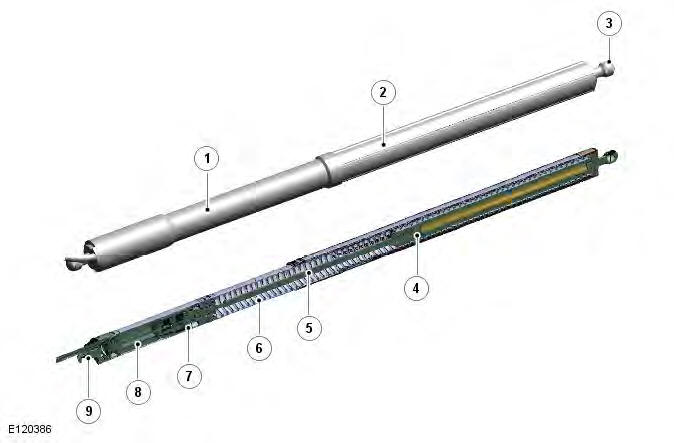
- Inner tube
- Outer tube
- Ball joint
- Outer tube spindle nut
- Spindle
- Springs
- Gear
- Motor
- Ball joint
The powered struts open and close the tailgate using an electrically driven spindle located in the struts internal electric motor. Ball-joints positioned at each end of the strut allow it to articulate between a fixed mount on the vehicle and the moveable tailgate. The tailgate opening operation is also aided by spring assistance.
The spindle drive comprises an inner and outer tube where the motor and gears in the inner tube drive a threaded spindle which runs on a threaded nut fixed to the inside of the outer tube.
The spindle drive incorporates an object detection function controlled by the tailgate module. The function is similar to the anti-trap function of a closing electric window but operates in both directions. If the object detection feature is activated while the tailgate is closing, the spindle motor stopped and then reversed for a preset period. If the object detection feature is activated while the tailgate is opening, the spindle motor is stopped and held at that position.
A hall sensor, located in the spindle motor, monitors the speed of the motor. If the speed decreases below a set threshold, indicating an obstruction and increasing the motor current draw, the power feed to the motor is reversed causing the tailgate to move in the opposite direction of travel.
The amount of travel in the opposite direction, before stopping, is determined by the hall sensor count. An exception to the object detection reverse travel function occurs when the tailgate is opening through its first few degrees of travel from the latched position. In these circumstances if an obstacle is detected the tailgate stops in the position of the obstruction and no travel in the opposite direction occurs.
Component Description
Powered Tailgate
Tailgate - release switches
The tailgate can be opened using the following:
- The release button on the Smart Key.
- The exterior release switch, providing the doors are unlocked and the gear selector is in Park (P).
- The interior release switch, providing:
- the vehicle is not locked or alarmed;
- the vehicle speed is not at 5 kilometer/hour (3 mile/hour) or above.
These switches will also de-latch the manual tailgate.
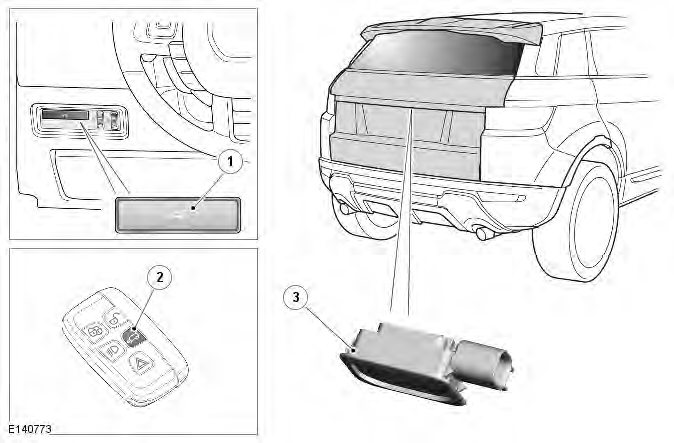
- Vehicle interior - release switch
- Smart Key - release button
- Vehicle exterior - release switch
Tailgate - close switch
The tailgate close switch is located on the tailgate closing edge.
The powered tailgate can also be manually closed, to either the latches' secondary or primary position, without causing any damage to the power mechanism.
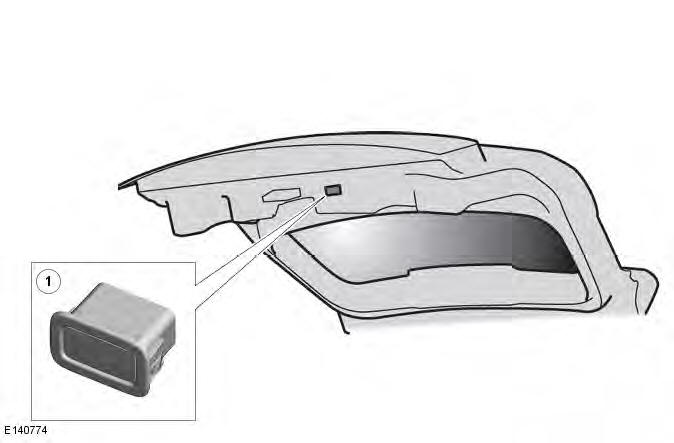
- Close switch
The tailgate can be stopped at any time during the open or close cycle by a single press on any of the tailgate control switches. Thereafter:
- Pressing any 'release' control switch will authorize the tailgate to continue or start opening.
- Pressing the 'close' control switch will authorize the tailgate to continue or start closing.
For further information, see chart below.
The tailgate has a 'Garage Position' setting, where it is possible to set the maximum height to which the tailgate will open.
To set the required height:
- Open the tailgate to the position of the required height and ensure the tailgate is stationary for at least three seconds.
- Press and hold, the tailgate close switch for a period of 10 seconds.
- Successful height programming will be indicated by the tailgate remaining stationary on the release of the close switch.
- Close the tailgate manually, or via the close switch, then open again to check that it opens to the programmed height.
The maximum opening height is now set. To reset the maximum opening height to full, repeat the process, but fully open the tailgate before pressing and holding the close switch.
NOTE: If the Smart Key is left inside the luggage compartment and the vehicle is locked and the alarm set, an audible warning will sound and the tailgate will re-open after three seconds.
The opening and closing control strategies are listed in the following chart:

If any object is detected that would interfere with the closing of the tailgate, the tailgate will stop and reverse a short distance. An audible mislock warning, that is 2 beeps from the security sounder, will indicate either a failed closing action or object detection. Any obstructions must be removed before pressing the close switch again.
The powered tailgate may lose its position memory if:
- there are multiple object detections,
- there are inadvertent loads on the tailgate while it is moving; for example a person leaning against the tailgate,
- the battery voltage is low.
The above may also inhibit the powered operation of the tailgate.
To reset the tailgate:
- Manually close the tailgate.
- Press a tailgate release switch.
- Allow the tailgate to power fully open or to the previously set position.
- Press and release the close switch.
- Allow the tailgate to power close fully.
The tailgate programmed position memory will now be restored.
Body Closures
Torque Specifications


